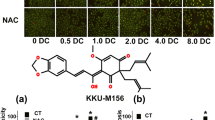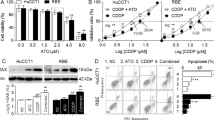Abstract
Cholangiocarcinoma (CCA) is an aggressive, metastatic bile duct cancer. CCA is difficult to diagnose, and responds poorly to current radio- and chemo-therapy. Piperlongumine (PL) is a naturally-occurring small molecule selectively toxic to cancer cells by targeting reactive oxygen species (ROS). In this study, we demonstrated the potential anticancer activity of PL in CCA. PL markedly induced death in CCA cell lines in a dose- and time-dependent manner through the activation of caspase-3 and PARP. PL also stimulated ROS accumulation in CCA. Co-exposure of PL with the ROS scavenger N-acetyl-l-cysteine or GSH completely blocked PL-induced apoptosis in CCA cell lines. Increased p21 via the p53-independent pathway in PL-treated CCA cells led to G2/M phase arrest and cell apoptosis. In addition, the study showed that PL trigger CCA cell lines death through JNK-ERK activation. Furthermore, the different antioxidant capacity of CCA cell lines also indicates the susceptibility of the cells to PL treatment. Our findings reveal that PL exhibits anti-tumor activity and has potential to be used as a chemotherapeutic agent against CCA.





Similar content being viewed by others
Abbreviations
- pAKT:
-
A three letter name (not an abbreviation); “p” stands for the phosphorylated (active) form
- BCL-2:
-
B cell lymphoma gene 2
- BAX:
-
BCL-2-associated protein X
- BAD:
-
BCL-2-associated death promoter
- pERK:
-
Phosphorylated (active) extracellular-signal-regulated kinase
- GAPDH:
-
Glyceraldehyde-3-phosphate dehydrogenase
- HRP:
-
Horseradish peroxidase
- pJNK:
-
Phosphorylated (active) C-Jun NH2-terminal kinase
- PARP:
-
Poly (ADP-ribose) polymerase
- p21:
-
21 kDa cyclin-dependent kinase inhibitor
- p53:
-
53 kDa tumor suppressor protein
- rpm:
-
Revolutions per minute
References
Kamangar F, Dores GM, Anderson WF (2006) Patterns of cancer incidence, mortality, and prevalence across five continents: defining priorities to reduce cancer disparities in different geographic regions of the world. J Clin Oncol 24(14):2137–2150. doi:10.1200/JCO.2005.05.2308
Jepsen P, Vilstrup H, Tarone RE, Friis S, Sørensen HT (2007) Incidence rates of Intra- and extrahepatic Cholangiocarcinomas in Denmark From 1978 Through 2002. J Natl Cancer Inst 99(11):895–897. doi:10.1093/jnci/djk201
Sripa B, Pairojkul C (2008) Cholangiocarcinoma: lessons from Thailand. Curr Opin Gastroenterol 24(3):349–356. doi:10.1097/MOG.0b013e3282fbf9b3
Bhudhisawasdi V, Talabnin C, Pugkhem A, Khuntikeo N, Seow OT, Chur-in S, Pairojkul C, Wongkham S (2012) Evaluation of postoperative adjuvant chemotherapy for intrahepatic cholangiocarcinoma patients undergoing R1 and R2 resections. Asian Pac J Cancer Prev 13(Suppl):169–174
Rizvi S, Gores GJ (2013) Pathogenesis, diagnosis, and management of cholangiocarcinoma. Gastroenterology 145(6):1215–1229. doi:10.1053/j.gastro.2013.10.013
Chatterjee A, Dutta CP (1967) Alkaloids of Piper longum Linn. I. Structure and synthesis of piperlongumine and piperlonguminine. Tetrahedron 23(4):1769–1781
Bezerra DP, Pessoa C, de Moraes MO, Saker-Neto N, Silveira ER, Costa-Lotufo LV (2013) Overview of the therapeutic potential of piplartine (piperlongumine). Eur J Pharm Sci 48(3):453–463. doi:10.1016/j.ejps.2012.12.003
Raj L, Ide T, Gurkar AU, Foley M, Schenone M, Li X, Tolliday NJ, Golub TR, Carr SA, Shamji AF, Stern AM, Mandinova A, Schreiber SL, Lee SW (2011) Selective killing of cancer cells by a small molecule targeting the stress response to ROS. Nature 475(7355):231–234. doi:10.1038/nature10167
Xiong XX, Liu JM, Qiu XY, Pan F, Yu SB, Chen XQ (2015) Piperlongumine induces apoptotic and autophagic death of the primary myeloid leukemia cells from patients via activation of ROS-p38/JNK pathways. Acta Pharmacol Sin 36(3):362–374. doi:10.1038/aps.2014.141
Chen Y, Liu JM, Xiong XX, Qiu XY, Pan F, Liu D, Lan SJ, Jin S, Yu SB, Chen XQ (2015) Piperlongumine selectively kills hepatocellular carcinoma cells and preferentially inhibits their invasion via ROS-ER-MAPKs-CHOP. Oncotarget 6(8):6406–6421
Zheng J, Son DJ, Gu SM, Woo JR, Ham YW, Lee HP, Kim WJ, Jung JK, Hong JT (2016) Piperlongumine inhibits lung tumor growth via inhibition of nuclear factor kappa B signaling pathway. Sci Rep 6:26357. doi:10.1038/srep26357
Roh J-L, Kim EH, Park JY, Kim JW, Kwon M, Lee B-H (2014) Piperlongumine selectively kills cancer cells and increases cisplatin antitumor activity in head and neck cancer. Oncotarget 5(19):9227–9238
Lee H-N, Jin H-O, Park J-A, Kim J-H, Kim J-Y, Kim B, Kim W, Hong S-E, Lee Y-H, Chang YH, Hong S-I, Hong YJ, Park I-C, Surh Y-J, Lee JK (2015) Heme oxygenase-1 determines the differential response of breast cancer and normal cells to piperlongumine. Mol Cell Biol 38(4):327–335. doi:10.14348/molcells.2015.2235
Duan C, Zhang B, Deng C, Cao Y, Zhou F, Wu L, Chen M, Shen S, Xu G, Zhang S, Duan G, Yan H, Zou X (2016) Piperlongumine induces gastric cancer cell apoptosis and G2/M cell cycle arrest both in vitro and in vivo. Tumour biol 37(8):10793–10804. doi:10.1007/s13277-016-4792-9
Voigt W (2005) Sulforhodamine B assay and chemosensitivity. Methods Mol Med 110:39–48. doi:10.1385/1-59259-869-2:039
Chou TC (2006) Theoretical basis, experimental design, and computerized simulation of synergism and antagonism in drug combination studies. Pharmacol Rev 58(3):621–681. doi:10.1124/pr.58.3.10
Thongsom S, Chaocharoen W, Silsirivanit A, Wongkham S, Sripa B, Choe H, Suginta W, Talabnin C (2016) YKL-40/chitinase-3-like protein 1 is associated with poor prognosis and promotes cell growth and migration of cholangiocarcinoma. Tumour biol 37(7):9451–9463. doi:10.1007/s13277-016-4838-z
Jin HO, Lee YH, Park JA, Lee HN, Kim JH, Kim JY, Kim B, Hong SE, Kim HA, Kim EK, Noh WC, Kim JI, Chang YH, Hong SI, Hong YJ, Park IC, Lee JK (2014) Piperlongumine induces cell death through ROS-mediated CHOP activation and potentiates TRAIL-induced cell death in breast cancer cells. J Cancer Res Clin Oncol 140(12):2039–2046. doi:10.1007/s00432-014-1777-1
Liu QR, Liu JM, Chen Y, Xie XQ, Xiong XX, Qiu XY, Pan F, Liu D, Yu SB, Chen XQ (2014) Piperlongumine inhibits migration of glioblastoma cells via activation of ROS-dependent p38 and JNK signaling pathways. Oxid Med Cell Longev 2014:653732. doi:10.1155/2014/653732
Son Y, Cheong Y-K, Kim N-H, Chung H-T, Kang DG, Pae H-O (2011) Mitogen-activated protein kinases and reactive oxygen species: how can ROS activate MAPK pathways? J Signal Transduct 2011:792639. doi:10.1155/2011/792639
Majewski N, Nogueira V, Bhaskar P, Coy PE, Skeen JE, Gottlob K, Chandel NS, Thompson CB, Robey RB, Hay N (2004) Hexokinase-mitochondria interaction mediated by Akt is required to inhibit apoptosis in the presence or absence of Bax and Bak. Mol Cell 16(5):819–830. doi:10.1016/j.molcel.2004.11.014
Halasi M, Wang M, Chavan TS, Gaponenko V, Hay N, Gartel AL (2013) ROS inhibitor N-acetyl-L-cysteine antagonizes the activity of proteasome inhibitors. Biochem J 454(2):201–208. doi:10.1042/BJ20130282
Bhat UG, Halasi M, Gartel AL (2009) FoxM1 is a general target for proteasome inhibitors. PLoS ONE 4(8):e6593. doi:10.1371/journal.pone.0006593
Gorrini C, Harris IS, Mak TW (2013) Modulation of oxidative stress as an anticancer strategy. Nat Rev Drug Discov 12(12):931–947. doi:10.1038/nrd4002
Liu J, Wang Z (2015) Increased oxidative stress as a selective anticancer therapy. Oxid Med Cell Longev 2015:294303. doi:10.1155/2015/294303
Maruyama M, Kobayashi N, Westerman KA, Sakaguchi M, Allain JE, Totsugawa T, Okitsu T, Fukazawa T, Weber A, Stolz DB, Leboulch P, Tanaka N (2004) Establishment of a highly differentiated immortalized human cholangiocyte cell line with SV40T and hTERT. Transplantation 77(3):446–451. doi:10.1097/01.TP.0000110292.73873.25
Boonstra J, Post JA (2004) Molecular events associated with reactive oxygen species and cell cycle progression in mammalian cells. Gene 337:1–13. doi:10.1016/j.gene.2004.04.032
Taylor WR, Stark GR (2001) Regulation of the G2/M transition by p53. Oncogene 20(15):1803–1815. doi:10.1038/sj.onc.1204252
Thorn T, Gniadecki R, Petersen AB, Vicanova J, Wulf HC (2001) Differences in activation of G2/M checkpoint in keratinocytes after genotoxic stress induced by hydrogen peroxide and ultraviolet A radiation. Free Radic Res 35(4):405–416
Chung YW, Jeong DW, Won JY, Choi EJ, Choi YH, Kim IY (2002) H(2)O(2)-induced AP-1 activation and its effect on p21(WAF1/CIP1)-mediated G2/M arrest in a p53-deficient human lung cancer cell. Biochem Biophys Res Commun 293(4):1248–1253. doi:10.1016/s0006-291x(02)00360-1
Zhang Z, Huang C, Li J, Leonard SS, Lanciotti R, Butterworth L, Shi X (2001) Vanadate-induced cell growth regulation and the role of reactive oxygen species. Arch Biochem Biophys 392(2):311–320. doi:10.1006/abbi.2001.2464
Bijur GN, Briggs B, Hitchcock CL, Williams MV (1999) Ascorbic acid-dehydroascorbate induces cell cycle arrest at G2/M DNA damage checkpoint during oxidative stress. Environ Mol Mutagen 33(2):144–152
Yoon H, Min J-K, Lee JW, Kim D-G, Hong HJ (2011) Acquisition of chemoresistance in intrahepatic cholangiocarcinoma cells by activation of AKT and extracellular signal-regulated kinase (ERK)1/2. Biochem Biophys Res Commun 405(3):333–337. doi:10.1016/j.bbrc.2010.11.130
Wilson JM, Kunnimalaiyaan S, Kunnimalaiyaan M, Gamblin TC (2015) Inhibition of the AKT pathway in cholangiocarcinoma by MK2206 reduces cellular viability via induction of apoptosis. Cancer Cell Int 15(1):13. doi:10.1186/s12935-015-0161-9
Chung JY, Hong SM, Choi BY, Cho H, Yu E, Hewitt SM (2009) The expression of phospho-AKT, phospho-mTOR, and PTEN in extrahepatic cholangiocarcinoma. Clin Cancer Res (2):660–667. doi:10.1158/1078-0432.ccr-08-1084
Kongpetch S, Kukongviriyapan V, Prawan A, Senggunprai L, Kukongviriyapan U, Buranrat B (2012) Crucial role of heme oxygenase-1 on the sensitivity of cholangiocarcinoma cells to chemotherapeutic agents. PLoS ONE 7(4):e34994. doi:10.1371/journal.pone.0034994
Kongpetch S, Puapairoj A, Ong CK, Senggunprai L, Prawan A, Kukongviriyapan U, Chan-On W, Siew EY, Khuntikeo N, Teh BT, Kukongviriyapan V (2016) Haem oxygenase 1 expression is associated with prognosis in cholangiocarcinoma patients and with drug sensitivity in xenografted mice. Cell Prolif 49(1):90–101. doi:10.1111/cpr.12228
Acknowledgements
The authors thank (a) Professor Banchob Sripa of the Department of Pathology, Faculty of Medicine, Khon Kaen University for providing the cholangiocarcinoma cells; (b) the Biochemistry Laboratory, the Center for Scientific and Technological Equipment, Suranaree University of Technology for providing the research facilities; (c) Professor Jong-Lyel Roh of Department of Otolaryngology, Asan Medical Center, University of Ulsan College of Medicine, Seoul, Korea for providing some of the piperlongumine; and, (d) Mr. Bryan Roderick Hamman for assistance with the English-language presentation of the manuscript.
Funding
This work was supported by grants from Suranaree University of Technology (Grant Number: SUT1-102-57-24-23) and the Young Research Grants, Thailand Research Fund (MRG6080055) to CS. HC was supported by Grants (NRF-2015K1A4A3046807 and 2008-0062286) from the National Research Foundation of Korea and a Grant (2017-307) from the Asan Institute for Life Sciences, Seoul, Korea.
Author information
Authors and Affiliations
Contributions
ST carried out all the experiments, performed data analysis, and prepared the manuscript draft. WS was provided advice on the cytotoxicity tests and data analysis. KJL supported and provided advice on the western blot analysis. HC was a grant holder, conceived the research, provided guidance on data analysis, revised and approved the manuscript. CT was a grant holder, designed the experiment, provided advice on the cell cycle analysis, ROS measurement, apoptosis assay, gene expression, and data analysis, revised and approved the manuscript.
Corresponding authors
Ethics declarations
Conflict of interest
The authors declare no conflicts of interest.
Electronic supplementary material
Below is the link to the electronic supplementary material.
10495_2017_1422_MOESM1_ESM.tif
Supplement Fig1. Anit-proliferative activity of PL on KKU-100 and NIH3T3. (a) KKU-100 and NIH3T3 were grown in 96-well plates for 24 h then treated with various concentration of PL range from 0-100 µM for 24 and 48 h. Cell viability was measured using SRB assays. Percentages of cell viability relative to control (without PL) are shown as mean ± SD from three independent experiments. *P < 0.05. (b) Western blot analysis of PL treated with NIH3T3. NIH3T3 was treated with PL at 10 µM for 0, 3, 6, 12, and 24 h. Activation of caspase-3, and PARP were examined using western blot analysis. β-actin was used as an equal loading control for normalization. (TIF 4716 KB)
Rights and permissions
About this article
Cite this article
Thongsom, S., Suginta, W., Lee, K.J. et al. Piperlongumine induces G2/M phase arrest and apoptosis in cholangiocarcinoma cells through the ROS-JNK-ERK signaling pathway. Apoptosis 22, 1473–1484 (2017). https://doi.org/10.1007/s10495-017-1422-y
Published:
Issue Date:
DOI: https://doi.org/10.1007/s10495-017-1422-y




